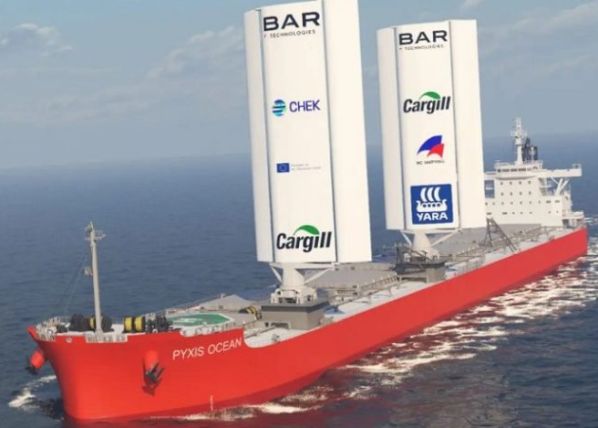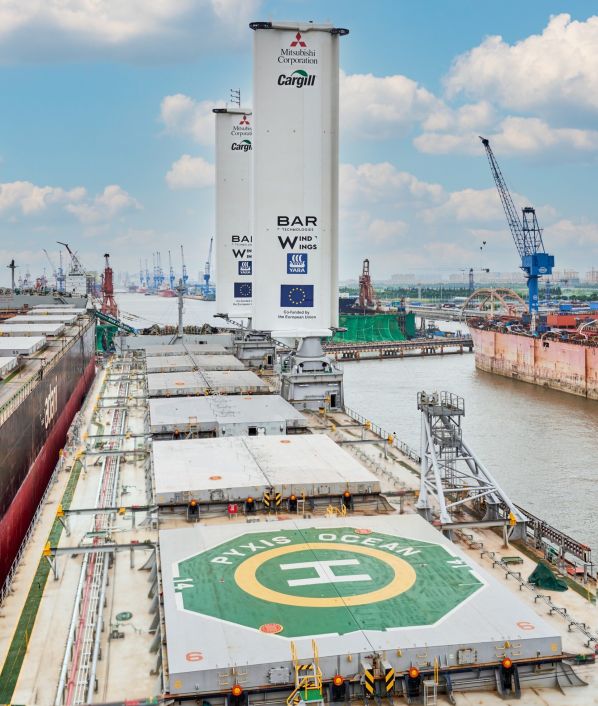AUTONEWS

A cargo ship equipped with rigid sails set off on its maiden voyage
A giant, rigid, British-designed bulk cargo ship equipped with sails has set sail for the first time. The vehicle is nowhere near as beautiful as the clippers of old, but charter shipping company Cargill hopes the technology will help the industry on its way to a greener future.
Named Pyxis Ocean, the first trip from Singapore to Paranagua, Brazil will also be the first real test of the WindWings sails. The aim of the prototype is to assess whether a return to the traditional way of propelling ships could be the way of the future in maritime freight transport. If successful, hundreds of ships will be retrofitted with sails. WindWings sails are designed to reduce fuel consumption and thus the carbon emissions of sailing. This is quite important, given that the industry is estimated to be the largest contributor to global carbon dioxide (CO2) is responsible for about 2.1% of emissions.
The rigid sails are 37.5 m high and are made of fiberglass, the same material as the wind turbines, to make them durable. Sails are furled in harbors and unfurled when the ship is on open water. Although the sails were designed to work in conjunction with the engine, during initial sea trials the cargo ship reached a speed of five and a half knots (about 9 km/h) using wind power alone. And this was far from the top speed, and all this was achieved at a wind speed of barely 18 knots. According to preliminary calculations, the technology can reduce the emissions of cargo ships by a third – in this case by three tons per day – compared to ships that rely solely on their engines. An even more serious change is that while most cargo ships today travel in a straight line, technology can change current shipping routes and make it more profitable to follow old trade routes with favorable winds.
“Five or six years ago, if you had asked people in shipping about decarbonisation, they would have said ‘well, it’s going to be very difficult, I don’t think it’s going to happen anytime soon’. But now the narrative has completely changed, and everybody’s convinced that they have to do their part, they’re just struggling a little bit with how we’re going to make that happen. As one of the bigger players, that’s why we’ve taken the lead to take some of the risk, try things, and push the industry.” – stated Jan Dieleman, president of Cargill Ocean Transportation. He pointed out that there is no panacea, but this technology is an excellent example of how quickly things change.
Cargill initially used traditional sails, but found they simply didn’t work and subsequently joined forces with Portsmouth-based BAR Technologies. This was not a smooth affair either, because initially the huge, curved sails placed on the deck obstructed the view from the bridge, so the team was forced to install cameras on the front of the ship. They also had to incorporate a tilting mechanism that would allow the sails to be retracted for operations at docks, passing under structures or in rough sea conditions.
In addition to the fact that each sail can turn, they have three movable elements that can be adjusted to the strength of the wind, similar to how an airplane wing changes shape during takeoff and landing. Wind speed sensors on board measure the angle and speed of the air flow and automatically adjust the sail in case of unexpected gusts. In gusty winds above 40 knots, the sails can be furled to the deck. There are also sensors that monitor the ship’s roll and how far it deviates from the set course. All of this should be completely automatic.

Pyxis Ocean is estimated to reach its destination in six weeks. They test whether the sails work as designed, whether the technology is safe, whether the wings can move as they should and whether they can be folded. Britain’s BAR Technologies grew out of Sir Ben Ainslie’s 2017 America’s Cup team, a competition sometimes called the “Formula 1 of the seas”. “This is one of the slowest projects we’ve done so far, but without a doubt it has the biggest impact on the planet,” said their leader, John Cooper – who used to work for Formula 1 team McLaren. He believes this trip will be a turning point for the shipping industry.
“I predict that by 2025, half of the new ships being built will be ordered with wind propulsion,” Cooper said. “I am so confident because we are saving one and a half tons of fuel every day. If we put four wings on a ship, that means saving six tons of fuel, which means 20 tons of CO2 means savings – daily. The numbers speak for themselves.” – He told.
The shipping industry is trying to reduce the estimated 837 million tons of carbon dioxide it emits annually. In this, wind energy can greatly help the sector, which wants to reduce the emission of gases that warm the planet to zero “by 2050 or around 2050”. But with traditional methods, it will be difficult to deliver on this promise because new, cleaner fuels will take time to appear. According to Dr Simon Bullock, a shipping researcher at the University of Manchester, “we need to do everything we can to transform the operation of existing ships, such as retrofitting ships with sails, kites and rotors”. “We need carbon-free fuels on all ships, but in the meantime it’s essential to make current operations as efficient as possible. Going slower is also a critical part of the solution,” he said.
Stephen Gordon, managing director of marine data provider Clarksons Research, agreed that wind-related technologies are gaining ground. “The number of ships using this technology has doubled in the last 12 months,” he explained. “However, this is starting from a low base. In the international shipping fleet of more than 110,000 vessels and in the newbuild order book, we have fewer than 100 vessels today that have wind technology.” And even if that number increases dramatically, wind technology may not be suitable for all ships, for example because sails interfere with the unloading of containers. “The shipping industry does not yet have a clear solution to operating carbon-free. Given the magnitude of the challenge and the diversity of the world’s shipping fleet, it is unlikely that there will be a single solution for the industry in the short to medium term,” predicted Gordon.
But John Cooper of BAR Technologies is more optimistic, saying that the future of windfoils is “very rosy” and that he also takes some satisfaction in seeing the industry return to its roots. “Engineers hate it, but I think it’s a return to the future,” he said. The entire project was tested on a “digital twin” inside a computer before the wings were built by Yara Marine Technologies. If Pyxis Ocean’s journey is successful, the team plans to test the wings on a Newcastlemax bulk carrier – one of the world’s largest cargo ships used to transport coal, iron ore and grain across the world’s oceans.
Source: SG.hu Hírmagazin
Nenhum comentário:
Postar um comentário